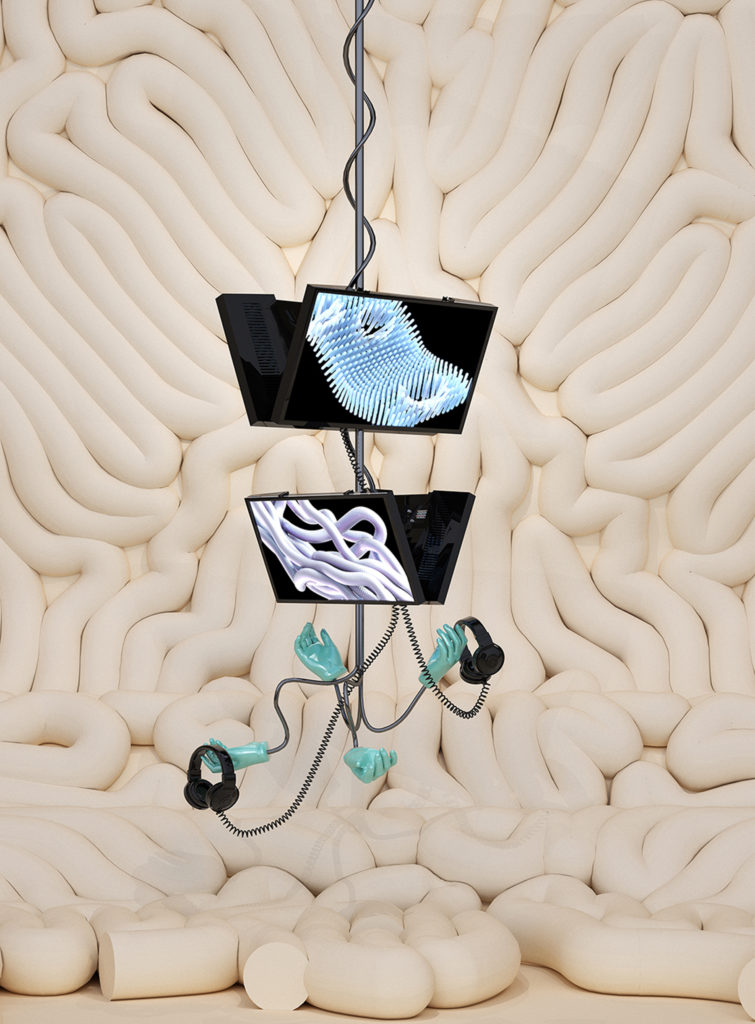More Authentic Screen Time
The exhibition on ASMR at ArkDes, an architecture and design centre in Stockholm, brings forth the sensory internet phenomenon.
All of a sudden, millions of people around the world are staring at their screens at someone smoking, slurping, whispering, tapping on the surface of a table with their fingernails, washing a dog, or even softly reading, for instance, the instructions for filing a tax return. Consequences: a tingling feeling in the brain; a meditative, enjoyable frame of mind; a kind of euphoric headache that gradually spreads throughout the body – if you happen to be one of those affected by ASMR stimuli.
The term ASMR, that is, autonomous sensory meridian response, was coined a decade ago to refer to calming sensations through the auditory, visual and tactile senses. ASMR artists seek to evoke these reactions in their viewers through videos, which are currently gaining up to tens of millions of views on Youtube. The reaction itself, however, is nothing new: according to researchers, watching the videos activates the same areas in the brain as, for example, brushing your hair or shaving. Affordable microphones, editing programs and digital distribution channels have just made the primitive sensations a viral phenomenon.

Weird Sensation Feels Good
2 June – 1 November 2020
Remote opening 7 April 2020, viewable online
Curator: James Taylor-Foster
Exhibition design: ĒTER
Graphic design: Irene Stracuzzi × PostNew
The ASMR exhibition at ArkDes, an architectural centre in Stockholm, was intended to give the internet phenomenon a physical form, but almost ironically it could not open as planned at the beginning of April, after the pandemic digitised almost every form of socialising. The opening months were postponed, but a remote opening was held for the exhibition on the planned day. In a carefully executed live broadcast, the opening turned into an interesting programme of current affairs and discussion, instead of the traditional clinking of wine glasses.
The first intentional ASMR video was reportedly uploaded on the internet in 2009. Academic ASMR research, however, is lagging behind: for example, it is not yet known why sensory stimuli strongly affect some people but others not at all. Not that the exhibition is seeking to provide answers, either. In their inaugural discussion, James Taylor-Foster, who curated the show, and Helga Sadowski, who has explored digital intimacy, wondered whether it is actually even possible to say whether the video boom might be a reaction to something or perhaps the beginning of something else. Nevertheless, making a contemporary phenomenon the theme of an exhibition obviously gives ArkDes an conscious role in setting the discussion agenda for design and architecture: Weird Sensation Feels Good is the world’s first ASMR-themed museum exhibition.
ASMR shows that technology can also be used to convey care and generate bodily pleasure.
The phenomenon has major observations to present. ASMR seems to turn many technology stereotypes on their heads: digital interaction is often accused of being abstract, instant messaging of being superficial, the faces on the screen as less of “real life” than actual physical encounters. In design and architecture, “authentic” materials and tactile experiences without hectic, flickering squares and constant sharing, have held their place as some kind of human-centred design ideal. ASMR shows, however, that technology can also be used to convey care and generate bodily pleasure.
In recent decades, architects have been particularly interested in the effects of digitalisation on urban environments and interpersonal interactions. Screens, first in the urban space and then in our pockets, have at times redefined the concept of public space as well as shrunk distances, and at other times made people objects of monitoring or generated new urban culture – accelerated, connected and networked. Helga Sadowski highlights how our relationship with digital devices and content is simultaneously also slow, personal and intimate: phones are present even in bed, the touch screens stained with trails of sweat from our fingers.

Whereas entertainment has traditionally sought to evoke extreme emotions, and in the 21st century emotions have been harnessed also in politics, ASMR is more about emptying the mind. In the ArkDes exhibition space, the installation of the multinational architectural studio ĒTER is like a cross between a laboratory and a spa, where the tingling of the body is sought while lounging among the videos on cushions imitating the folds of the brain, dressed in white bathrobes, with headphones covering the ears.
Seeking pleasure from whispering or from videos about washing dogs may just be a weird, hedonistic, and fleeting fetish. Equally, however, it is conceivable that empathy-linked ASMR could be utilised even as a form of mental health care, as several experts familiar with the phenomenon pointed out at the exhibition’s opening. Online fads, which have seemed marginal, have in the past revolutionised both everyday life and working life. It will undoubtedly have a wide range of consequences for architecture and design as well, if we yearn for increasingly more care and attention. ↙